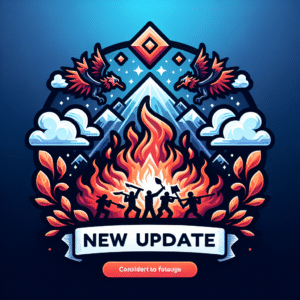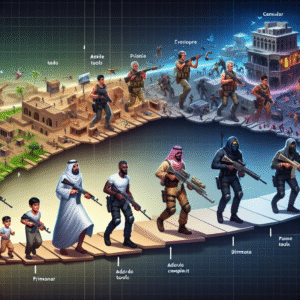Interview with the Creators of Candy Crush Saga
In the bustling world of mobile gaming, few titles have achieved the meteoric rise and sustained popularity of Candy Crush Saga. Launched in 2012 by the developer King, this highly addictive puzzle game has captivated millions worldwide. This interview with its creators sheds light on the ingenious minds behind Candy Crush Saga and explores the elements that have contributed to its unprecedented success.
Before Candy Crush Saga, King had established itself as a force in the gaming world, operating a website offering casual games. However, the leap to a mobile-based platform was a watershed moment not only for King but also for its creators, who envisioned reaching a global audience. At the heart of Candy Crush Saga’s success lies the collaborative genius of a dynamic team led by creator and Creative Director Sebastian Knutsson, whose background in computer science and unwavering passion for gaming provided a solid foundation for innovation.
From the get-go, Knutsson and his team aimed to design a game that was accessible and appealing to a broad demographic. The development process was steeped in creativity and strategy. “We wanted to make a game that married simplicity with strategy—something that could be both an occasional pastime and an all-consuming challenge,” Knutsson explained. Much of the game’s appeal lies in its seemingly simple mechanics that quickly give way to complex puzzles, creating an engaging user experience tailored to both novice gamers and seasoned strategists.
A crucial conversation with the development team revealed their intense focus on user experience design—a key component that propelled Candy Crush Saga to fame. Tapping into this, Lead Designer Tommy Palm emphasized the importance of listening to player feedback. “It’s about the players—their engagement, satisfaction, and how they connect with the game. Continuous updates and tweaks ensure we maintain their interest over the years,” Palm said. This player-centric philosophy has resulted in regular updates to the game, making it feel fresh and relevant even after a decade since launch.
Adding another layer of intrigue to the game was its narrative element—a novel concept in a puzzle game at the time. Producer Rikard Steiber highlighted the depth this added, stating, “Integrating a storyline keeps players invested. As players progress, they are not just clearing levels, but also unfolding a sweet adventure.” The vibrant, whimsical characters and settings further immerse players in the sugary world of Candy Crush, a strategy that proved integral to retaining long-term user interest.
The creators credit part of their triumph to the strategic use of data analytics. By meticulously analyzing user behavior and preferences, the team could innovate dynamically—enhancing gameplay features and puzzling challenges tailored to different skill levels. Data-driven insights empowered them to refine difficulty curves, ensuring player progression was challenging yet not frustrating, allowing for an “easy to learn, hard to master” gameplay ethos to shine through.
Social integration also played a pivotal role in Candy Crush Saga’s rise. “We understood early the power of shared experiences, especially when mobile gaming was still maturing,” said Co-founder Riccardo Zacconi. The connectivity aspect encouraged collaboration and competition, transforming solitary gaming sessions into shared endeavors. Features that let users invite friends, share progress, and compete on leaderboards amplified engagement and virality, contributing to a community that remains robust to this day.
Delving into the monetization approach, the creators emphasized their commitment to fairness and player choice. Candy Crush Saga employed a ‘freemium’ model—a strategy that allows players to experience the entirety of the game for free, while offering optional in-game purchases for enhancements and boosters. This model, initially met with skepticism, was groundbreaking and widely emulated later. “Monetization is balanced so that players do not feel forced to spend; rather, they choose to enhance their experience if they wish,” clarified Chief Financial Officer Stephane Kurgan, highlighting the transparency and choice at the core of their approach.
Candy Crush Saga’s distinctive art style—characterized by bright colors, pleasing animations, and delightful sounds—also contributed immensely to its success. Knutsson and his team took an iterative approach to the design. The eye-catching graphics and charming sound effects were not merely aesthetic choices but deliberate elements that heightened the sensory engagement, a factor that has proven crucial in establishing emotional connections with players.
Throughout the interview, it became clear that the success of Candy Crush Saga was not a mere stroke of luck. Rather, it was a carefully orchestrated symphony of creative design, technological innovation, strategic execution, and a relentless pursuit of user-centered experiences. Knutsson encapsulated the development ethos succinctly: “Caring for our players and striving to deliver joy is at the core of everything we do.”
As Candy Crush Saga continues to engage millions and redefine mobile gaming standards, its creators remain deeply invested in its evolution. Their journey reflects a blend of passion, creativity, and strategic acumen, demonstrating that enduring success in the mobile gaming industry is achievable with a visionary approach. The game stands as a testament to the potential of mobile platforms in crafting experiences that are as enriching as they are entertaining. Through the lens of Candy Crush Saga, the creators continue to inspire, innovate, and challenge boundaries, shaping the future of casual gaming one sweet puzzle at a time.











Post Comment